I'm just curious: I thought that tubifex worms were definitely out-of-favor as food for just about any aquarium fish, especially discus, because of their high pathogen counts. I get it that irradiation and freeze-drying render most pathogens inviable, but these procedures do not destroy pathogen-derived toxins that have already accumulated in the worms (just as cooking does not destroy toxins that produce 'food poisoning'). In any event, I haven't used tubifex of any sort for at least 30 years, switching to bloodworms, and then brine shrimp. I don't use any of those things anymore, because the fishes I keep cannot tolerate high-protein foods. 
You are using an out of date browser. It may not display this or other websites correctly.
You should upgrade or use an alternative browser.
You should upgrade or use an alternative browser.
Roy's 30 Gallon Red Spot Green Discus F1
- Thread starter Seattle_Aquarist
- Start date
Seattle_Aquarist
Well-Known Member
Hi @sir_keith,
I've used FD tubifex worms for my fish since the 1960's when Miracle brands first came out with it; and specifically San Francisco Bay Brand since it became irradiated. I have never had any issues with regards to disease or toxicity that I can attribute to feeding tubifex. I don't do blackworms, including Aquatic Foods (aka California) blackworms for the issues you bring up. I talked to the owner of CA Blackworms a few years ago and he stated that they do irradiate their FD product but I don't recall it being stated on any of the literature so I don't use the product. I also feed frozen bloodworms brine shrimp, I much prefer the Hikari products for both of these because I believe they are much 'cleaner' than some others I tried in the past.
I agree a steady diet of high-protein foods is not good for any species and as a good fish keeper it is my responsibility to provide a varied diet with protein, carbs, and fiber.
I've used FD tubifex worms for my fish since the 1960's when Miracle brands first came out with it; and specifically San Francisco Bay Brand since it became irradiated. I have never had any issues with regards to disease or toxicity that I can attribute to feeding tubifex. I don't do blackworms, including Aquatic Foods (aka California) blackworms for the issues you bring up. I talked to the owner of CA Blackworms a few years ago and he stated that they do irradiate their FD product but I don't recall it being stated on any of the literature so I don't use the product. I also feed frozen bloodworms brine shrimp, I much prefer the Hikari products for both of these because I believe they are much 'cleaner' than some others I tried in the past.
I agree a steady diet of high-protein foods is not good for any species and as a good fish keeper it is my responsibility to provide a varied diet with protein, carbs, and fiber.
Seattle_Aquarist
Well-Known Member
Hi All,
Here is what has been happening in the tank since I added the discus.
This last week I increased the PAR from PAR@20 to PAR@40 on Tuesday and then on Saturday I increased it from PAR@40 to PAR@70 (all measured at the substrate level).
I did a 50% water change yesterday making sure to match within 5 degrees the new water with the tank water. I added 3/8 tsp CaSO4 (3 ppm Ca / 0.4 dGH); 3/16 tsp MgSO4 (1.04 ppm Mg / 0.25 dGH); 3/16 tsp K2SO4 (7.5 ppm K)
The water parameters today are:
pH = 7,2
dKH = 2.0
dGH = 4.0
NH3 = 0.25 ppm
NO2 = 0.25 ppm
NO3 = 10 ppm
The ammonia level remains stable and I attribute the not before seen levels of nitrite and nitrates to the addition of the discus and the large amounts of food they consume. I will likely do a second water change on Friday and check the water parameters again.
Here is an overall view of the 30 gallon

The Trident Java Fern (Microsporum pteropus 'Trident') is doing well and looking good. The Cryptocoryne wendtii 'Green Gecko' has put out more leaves in the last couple of weeks than it did in the previous 3 months, I think the substrate feeding is having a positive effect.

Here is an overall view of the center of the tank. The Eriocaulon sp 'Vietnam' is growing although slowly with no signs of algae on the leaves. In fact, I haven't seen any algae whatsoever on the glass or plants since they were planted.
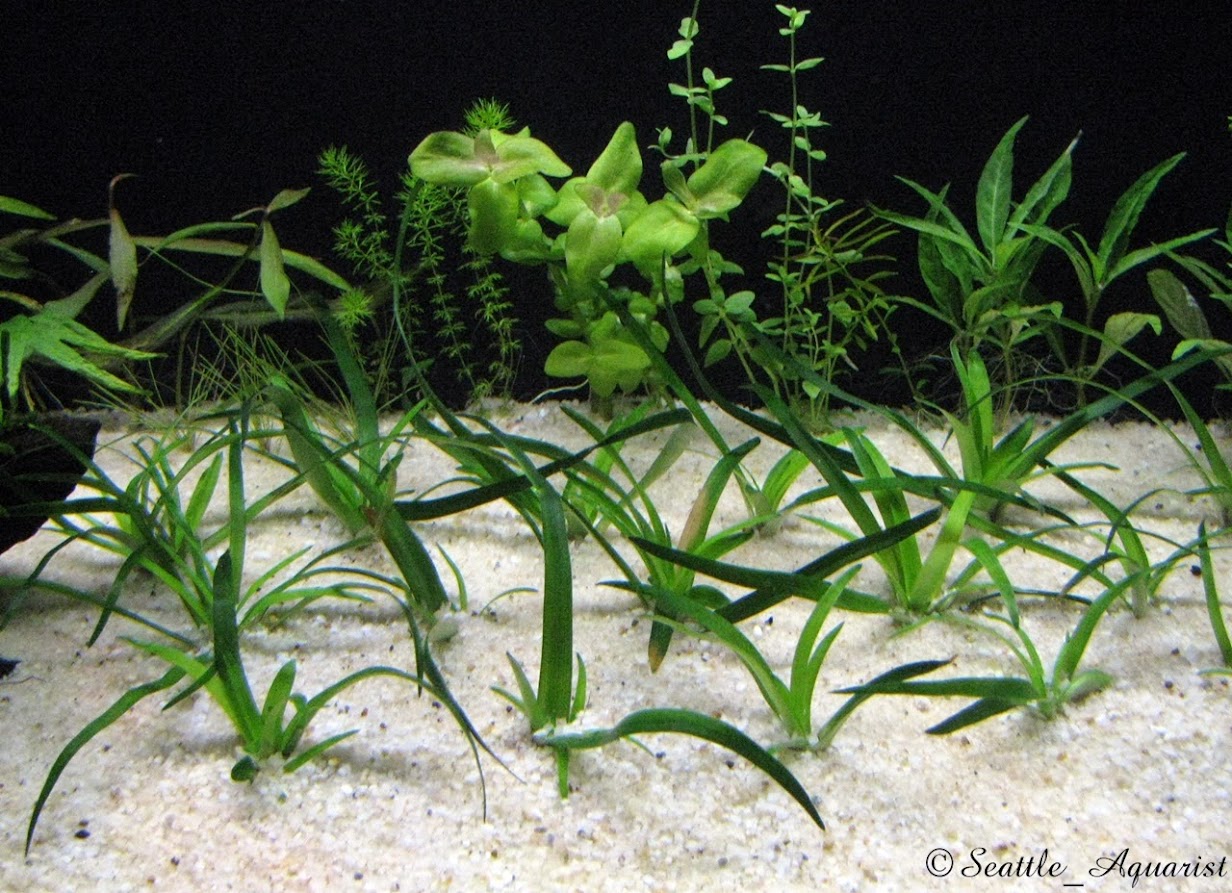
Here is a shot of some of the plants I am experimenting with along the back glass. These all come from my emersed plant bank and were planted July 30th so they have been in place about 11 days. This picture shows the Myriophyllum 'Mini' and the Bacopa colorata. Note the top leaves are noticeably larger on the 'Mini' compared with the lower leaves that were grown emersed. The same is true of the B. colorata but it is difficult to see in the picture. Also notice the top leaves are starting to show some pinkish coloration.

The Limnophila rugosa has put out several new leaves and is starting to look 'bushy'. The Ludwigia sp 'Red' has gone crazy (arrow) it must have 10 new nodes and the new submerged leaves are 5X the size of the emersed leaves. The leaves are green likely due to the low PAR level I have been using but the stems are growing toward the top and with the higher PAR I would expect to start seeing some normal color.
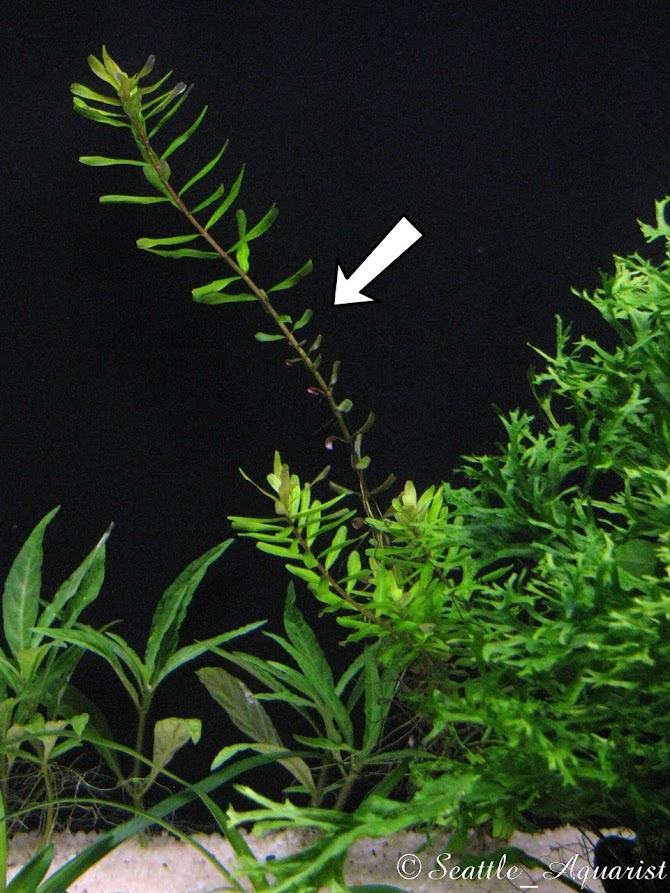
Here is what has been happening in the tank since I added the discus.
This last week I increased the PAR from PAR@20 to PAR@40 on Tuesday and then on Saturday I increased it from PAR@40 to PAR@70 (all measured at the substrate level).
I did a 50% water change yesterday making sure to match within 5 degrees the new water with the tank water. I added 3/8 tsp CaSO4 (3 ppm Ca / 0.4 dGH); 3/16 tsp MgSO4 (1.04 ppm Mg / 0.25 dGH); 3/16 tsp K2SO4 (7.5 ppm K)
The water parameters today are:
pH = 7,2
dKH = 2.0
dGH = 4.0
NH3 = 0.25 ppm
NO2 = 0.25 ppm
NO3 = 10 ppm
The ammonia level remains stable and I attribute the not before seen levels of nitrite and nitrates to the addition of the discus and the large amounts of food they consume. I will likely do a second water change on Friday and check the water parameters again.
Here is an overall view of the 30 gallon
The Trident Java Fern (Microsporum pteropus 'Trident') is doing well and looking good. The Cryptocoryne wendtii 'Green Gecko' has put out more leaves in the last couple of weeks than it did in the previous 3 months, I think the substrate feeding is having a positive effect.
Here is an overall view of the center of the tank. The Eriocaulon sp 'Vietnam' is growing although slowly with no signs of algae on the leaves. In fact, I haven't seen any algae whatsoever on the glass or plants since they were planted.
Here is a shot of some of the plants I am experimenting with along the back glass. These all come from my emersed plant bank and were planted July 30th so they have been in place about 11 days. This picture shows the Myriophyllum 'Mini' and the Bacopa colorata. Note the top leaves are noticeably larger on the 'Mini' compared with the lower leaves that were grown emersed. The same is true of the B. colorata but it is difficult to see in the picture. Also notice the top leaves are starting to show some pinkish coloration.
The Limnophila rugosa has put out several new leaves and is starting to look 'bushy'. The Ludwigia sp 'Red' has gone crazy (arrow) it must have 10 new nodes and the new submerged leaves are 5X the size of the emersed leaves. The leaves are green likely due to the low PAR level I have been using but the stems are growing toward the top and with the higher PAR I would expect to start seeing some normal color.
...Here is what has been happening in the tank since I added the discus...
Thanks for the update; it's coming along nicely. I hope you'll keep posting these; it will be fun to watch the plants grow, virtually of course! Also nice to learn something about aquascaping.
Those look like very nice and healthy discus; did you get them locally? What strain are they? I'm always flirting with the idea of setting up a soft-water show tank. I still miss my angelfish colonies from back in the 90's.
Seattle_Aquarist
Well-Known Member
Hi @sir_keith
I'll probably keep up the posts for some time. Right now I am just experimenting with plant species that will do well in the soft water, very warm tank. I will do some aquascaping further along.
Yes, I got them from a local breeder who is a member of GSAS. They are Symphysodon aequifasciatus F1 from Rio Nanay in Peru. Common name Red Spot Green Discus.
We do have great water here in Seattle for soft water species! -Roy
I'll probably keep up the posts for some time. Right now I am just experimenting with plant species that will do well in the soft water, very warm tank. I will do some aquascaping further along.
Yes, I got them from a local breeder who is a member of GSAS. They are Symphysodon aequifasciatus F1 from Rio Nanay in Peru. Common name Red Spot Green Discus.
We do have great water here in Seattle for soft water species! -Roy
... We do have great water here in Seattle for soft water species...
Not so much here, on the south side of Liberty Bay. I have a 200-foot well, and the water is alkaline and mineral-rich; great for Rift Lake cichlids; not so much for Neotropicals.
I think it is absolutely awesome that you have discus that are F1 from wild; they are just so much more robust than all the tank-raised (or line-bred) strains that have been developed over the years. I'll be curious to see how these discus color up as they mature. Just love wild discus.
I've spent time in Iquitos, and collected fishes on the Rio Nanay, mostly piranhas on a hook and line, but also some astounding angels. Another example of an awesome fish that has lost some of its natural beauty by careless breeding in captivity.
Seattle_Aquarist
Well-Known Member
Hi All,
Time for another weekly installment!
2020/08/13
Today I did a 6 gallon water change on the tank.
2020/08/16
I took ammonia, nitrite and nitrate readings again today, they were:
NH3 = 0.25 ppm
NO2 = 0.00 ppm
NO3 = 10 - 20 ppm
2020/08/17
Today is water change day. I changed 50% of the water in the tank (approximately 12 gallons) and did a light vacuum of the substrate in the front to remove detritus and the top layer of sand was looking a little dingy. I added 3/8 tsp of CaSO4 for 3 ppm of calcium, 3/16 tsp of MgSO4 for 1.0 ppm of Mg, and 3/16 tsp of K2SO4 for 7.5 ppm of potassium. I also added 15 ml of Excel/glutaraldehyde for carbon molecules. The fish all ate well about an hour afterwards on San Francisco Bay Brand freeze dried tubifex worms (FDTW). I took some pictures of the tank as well, here they are:
The full view
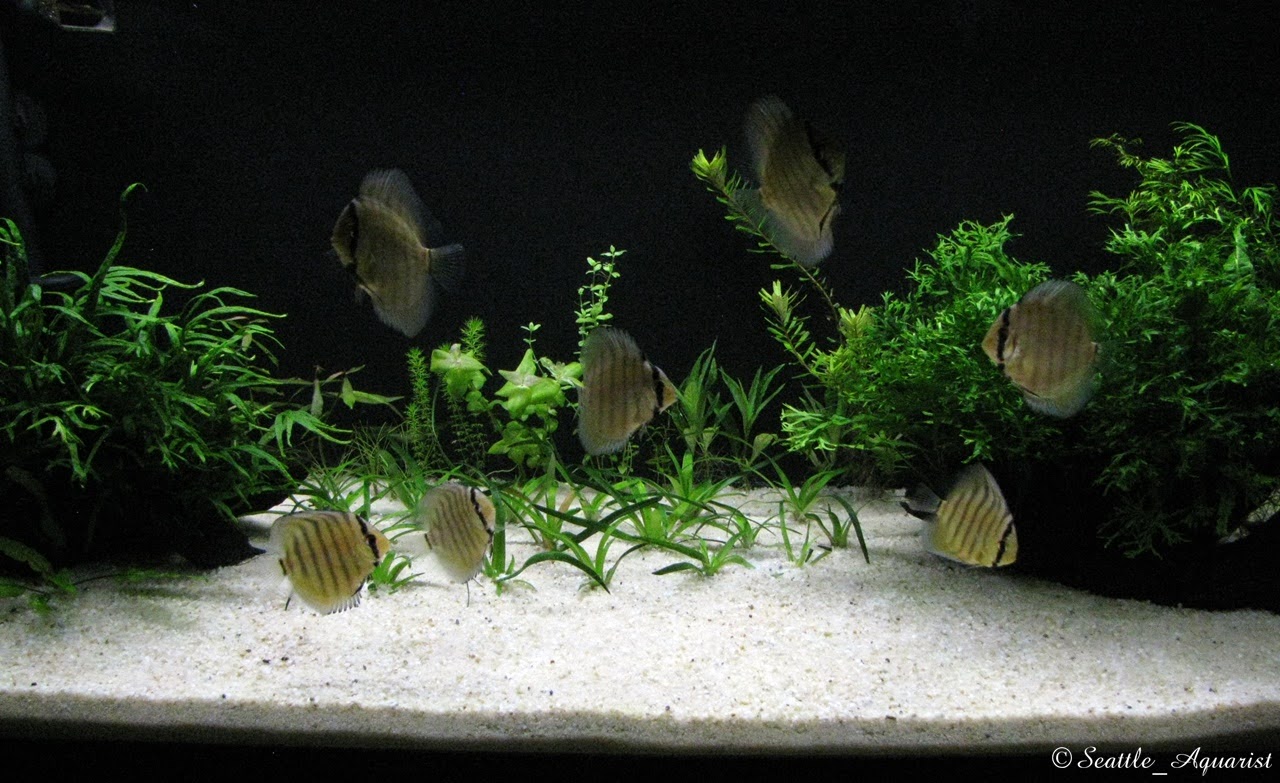
The C. wendtii 'Green Gecko' added another leaf this week. The 'Trident' is doing well

The Persicaria sp. 'Kawagoeanum' is not doing well, the leaves are small and not well formed and the growth has slowed. On the other hand the Myriophyllum sp. 'Guyana' continues to grow well with about 4 nodes (1") of new leaves.

Another shot of the Red Spot Green Discus (RSGD), they are almost always schooling

Not much noteworthy on the rest of the plants other than the three small sprigs of Ludwigia arcuata are showing new submerged growth and the Limnophila rugosa is branching at the bottom.
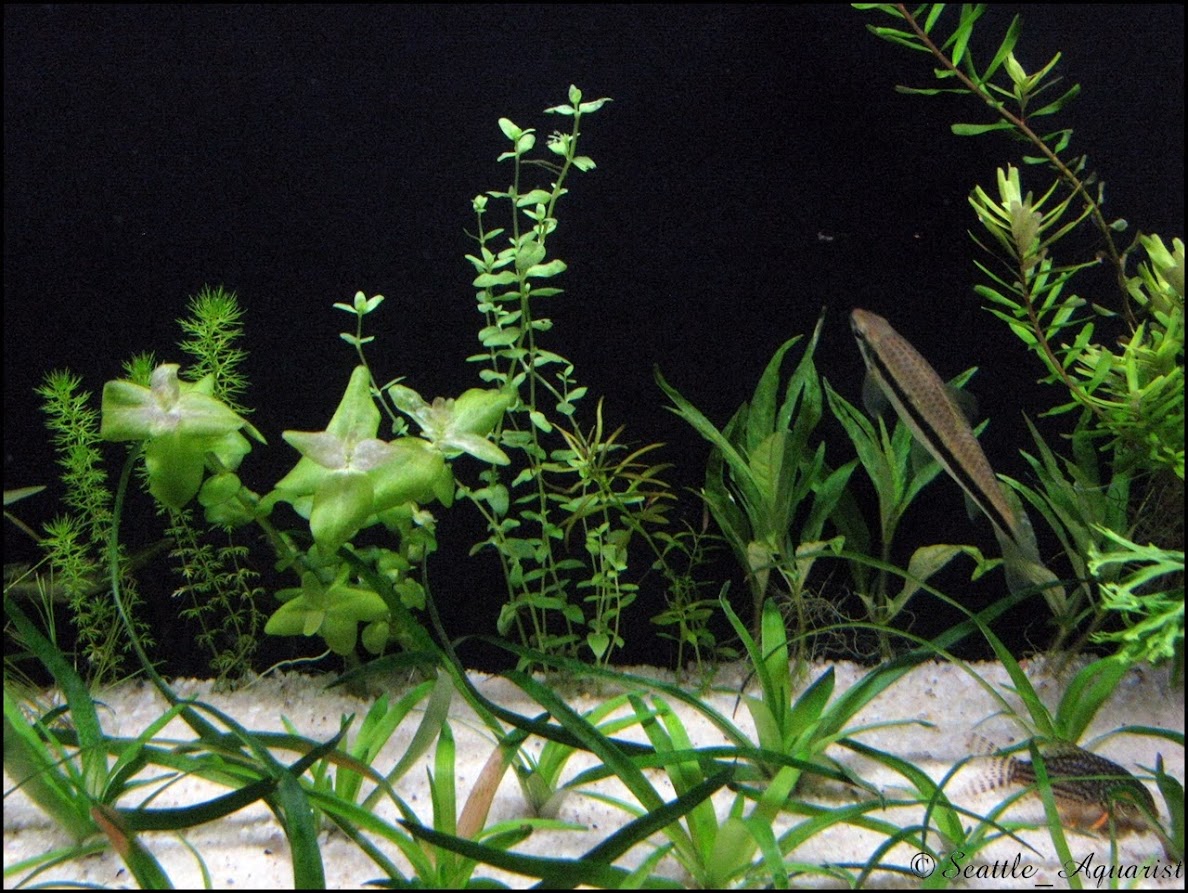
Lastly, the Ludwigia sp. 'Red' continues to grow quickly, however PAR@75 at the substrate and PAR@120 at the tip of the tall stem is not yet creating red coloration, however the stem is starting to branch.
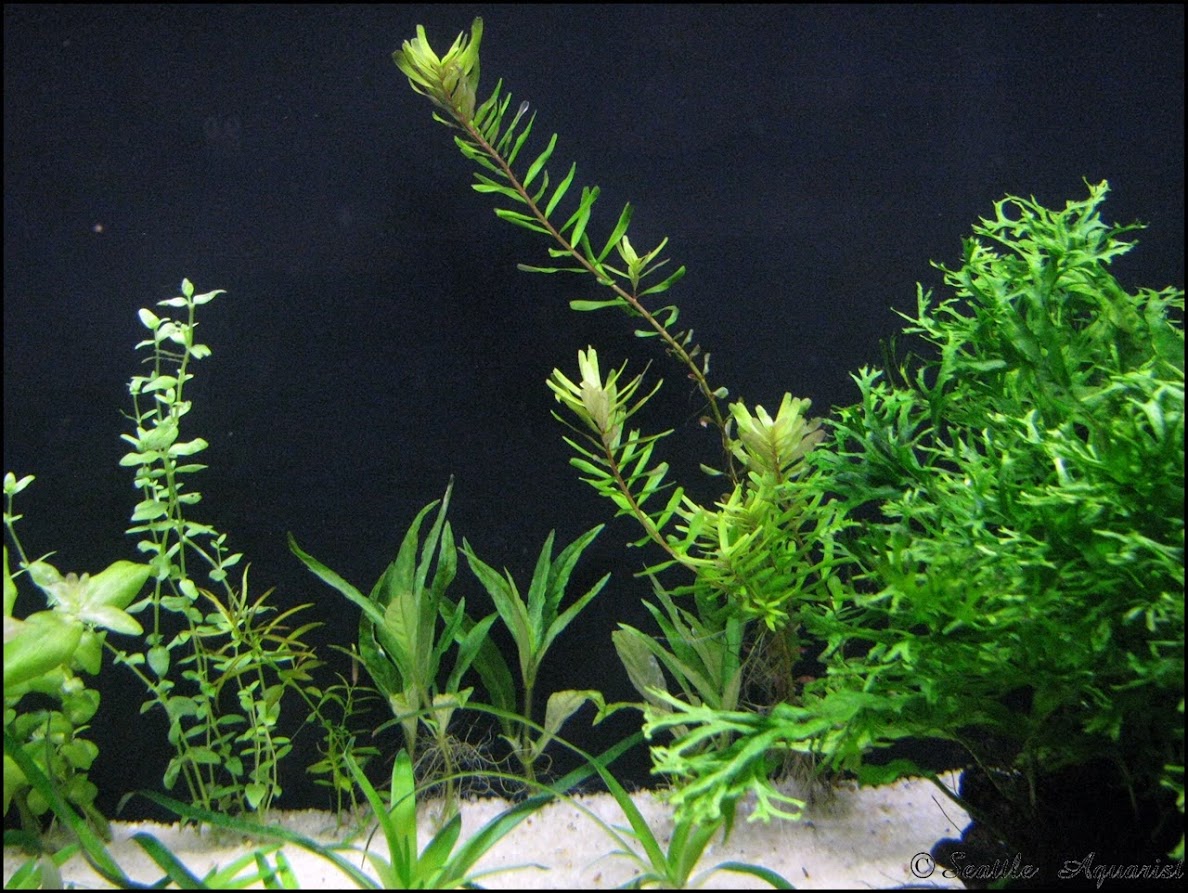
Time for another weekly installment!
2020/08/13
Today I did a 6 gallon water change on the tank.
2020/08/16
I took ammonia, nitrite and nitrate readings again today, they were:
NH3 = 0.25 ppm
NO2 = 0.00 ppm
NO3 = 10 - 20 ppm
2020/08/17
Today is water change day. I changed 50% of the water in the tank (approximately 12 gallons) and did a light vacuum of the substrate in the front to remove detritus and the top layer of sand was looking a little dingy. I added 3/8 tsp of CaSO4 for 3 ppm of calcium, 3/16 tsp of MgSO4 for 1.0 ppm of Mg, and 3/16 tsp of K2SO4 for 7.5 ppm of potassium. I also added 15 ml of Excel/glutaraldehyde for carbon molecules. The fish all ate well about an hour afterwards on San Francisco Bay Brand freeze dried tubifex worms (FDTW). I took some pictures of the tank as well, here they are:
The full view
The C. wendtii 'Green Gecko' added another leaf this week. The 'Trident' is doing well
The Persicaria sp. 'Kawagoeanum' is not doing well, the leaves are small and not well formed and the growth has slowed. On the other hand the Myriophyllum sp. 'Guyana' continues to grow well with about 4 nodes (1") of new leaves.
Another shot of the Red Spot Green Discus (RSGD), they are almost always schooling
Not much noteworthy on the rest of the plants other than the three small sprigs of Ludwigia arcuata are showing new submerged growth and the Limnophila rugosa is branching at the bottom.
Lastly, the Ludwigia sp. 'Red' continues to grow quickly, however PAR@75 at the substrate and PAR@120 at the tip of the tall stem is not yet creating red coloration, however the stem is starting to branch.
Seattle_Aquarist
Well-Known Member
Hi @sir_keith
All of my tanks have a 'cleaning crew' consisting of Corydoras, Siamese Algae Eater (great for 'hair type' algae and BBA - if I weaken the BBA with hydrogen peroxide, and Otocinclus for soft green algae and diatoms.
As a side note I should say that this is the second tank I have set up with basically no water column dosing. I am using 'inert' substrates (Safe-t-sorb in the first one; HTH Pool Filter Sand in this one) with Osmocote Plus root tabs and supplementing the tabs with doses of Seachem Comprehensive twice a week for additional micro-nutrients. In both tanks I am getting minimal if any algae on the glass, hardscape, or plants. Hmm, does water column nutrient dosing increase the likelihood of algae?
Both tanks have the same LED lights they had when water column dosing and the same photoperiod. Interesting. -Roy
All of my tanks have a 'cleaning crew' consisting of Corydoras, Siamese Algae Eater (great for 'hair type' algae and BBA - if I weaken the BBA with hydrogen peroxide, and Otocinclus for soft green algae and diatoms.
As a side note I should say that this is the second tank I have set up with basically no water column dosing. I am using 'inert' substrates (Safe-t-sorb in the first one; HTH Pool Filter Sand in this one) with Osmocote Plus root tabs and supplementing the tabs with doses of Seachem Comprehensive twice a week for additional micro-nutrients. In both tanks I am getting minimal if any algae on the glass, hardscape, or plants. Hmm, does water column nutrient dosing increase the likelihood of algae?
Both tanks have the same LED lights they had when water column dosing and the same photoperiod. Interesting. -Roy
Hi @sir_keith
All of my tanks have a 'cleaning crew' consisting of Corydoras, Siamese Algae Eater (great for 'hair type' algae and BBA - if I weaken the BBA with hydrogen peroxide, and Otocinclus for soft green algae and diatoms.
As a side note I should say that this is the second tank I have set up with basically no water column dosing. I am using 'inert' substrates (Safe-t-sorb in the first one; HTH Pool Filter Sand in this one) with Osmocote Plus root tabs and supplementing the tabs with doses of Seachem Comprehensive twice a week for additional micro-nutrients. In both tanks I am getting minimal if any algae on the glass, hardscape, or plants. Hmm, does water column nutrient dosing increase the likelihood of algae?
Both tanks have the same LED lights they had when water column dosing and the same photoperiod. Interesting. -Roy
Interesting. Are you keeping just a single SAE per tank? Years ago I was told that they need to be kept in groups to be happy, but then again, I was also told that they would not survive pH~9 water, and would grow too large (~6") for my 6-foot tanks. Several years later, I have groups of 6-8 SAE's in all my bigger tanks; they seem perfectly happy in the hard, alkaline water, and none of them have grown larger than about 3". So much for conventional wisdom. Isn't conventional wisdom also that otto's and cory's like to be kept in groups?
I am by no means knowledgeable about aquatic plant cultivation, but doesn't it seem intuitively obvious that adding nutrients to the water would promote the growth of algae? My low-tech approach to this problem has been to turn the lights down, and as I only have low-light plants- or none at all- I can get away with this. That's not to say I don't have algae...
Seattle_Aquarist
Well-Known Member
Hi @sir_keith
I too have heard that SAE like to be kept in groups, and in my 75 gallon I have three of them but all the rest of the tanks are singles. In the decade plus that I have been doing this I only had one instance where an SAE 'got mean' and starting attacking some marble veil angels.....that SAE is no longer with me. Low light is great, makes for lower maintenance on a weekly basis. -Roy
I too have heard that SAE like to be kept in groups, and in my 75 gallon I have three of them but all the rest of the tanks are singles. In the decade plus that I have been doing this I only had one instance where an SAE 'got mean' and starting attacking some marble veil angels.....that SAE is no longer with me. Low light is great, makes for lower maintenance on a weekly basis. -Roy
Roy-
I think the longer you are in this hobby, the more suspicious you become about 'conventional wisdom.' I have a collection of old aquarium hobby magazines from the 30's and 40's (I wasn't around then!), and you wouldn't believe some of the nonsense that was being promulgated back then. Remember the self-sustaining 'balanced aquarium'? Yikes!
I have also become skeptical about broad generalizations. This is particularly prevalent in Rift Lake cichlids. For example, Lake Tanganyika, the second largest fresh water lake in the world, is home to more than 100 genetically distinct populations currently assigned to the genus Tropheus. And yet blanket statements about the husbandry of the entire genus abound. It's even worse for the rock-dwelling fishes of Lake Malawi- the Mbuna- which comprise several different genera. It can be frustrating at times, but it is also what makes the hobby interesting.
I think the longer you are in this hobby, the more suspicious you become about 'conventional wisdom.' I have a collection of old aquarium hobby magazines from the 30's and 40's (I wasn't around then!), and you wouldn't believe some of the nonsense that was being promulgated back then. Remember the self-sustaining 'balanced aquarium'? Yikes!
I have also become skeptical about broad generalizations. This is particularly prevalent in Rift Lake cichlids. For example, Lake Tanganyika, the second largest fresh water lake in the world, is home to more than 100 genetically distinct populations currently assigned to the genus Tropheus. And yet blanket statements about the husbandry of the entire genus abound. It's even worse for the rock-dwelling fishes of Lake Malawi- the Mbuna- which comprise several different genera. It can be frustrating at times, but it is also what makes the hobby interesting.
Seattle_Aquarist
Well-Known Member
Hi @sir_keith,
Generalizations are just that, many times they do not apply to the specific species or situation that I am discussing. It is my responsibility to comb through manure and find the nugget of truth.
Generalizations are just that, many times they do not apply to the specific species or situation that I am discussing. It is my responsibility to comb through manure and find the nugget of truth.
Last edited:
Seattle_Aquarist
Well-Known Member
Hi All,
2020-08-21
Today I did a six (6) gallon water change. The tank has a water volume of 24 gallons so 25%. Here are the water parameters after the water change:
pH = 6.8
dKH = 2.0
dGH = 3.0
NH3 = 0.0 ppm
NO2 = 0.0 ppm
NO3 = 5.0 ppm
I did a light gravel vac in the front again, added 3/8 tsp of CaSO4 for 3 ppm of calcium, 3/8 tsp of MgSO4 for 2.0 ppm of Mg, and 3/16 tsp of K2SO4 for 7.5 ppm of potassium. Why did I dose those nutrients? I noticed the deformed new leaves of the Bacopa colorata which is likely insufficient calcium. I also noticed the necrosis occurring in the older leaves of the Eriocaulon 'Vietnam; likely insufficient potassium or magnesium. Lastly the Limnophila rugosa was showing interveinal chlorosis on the older leaves indicating insufficient magnesium and the older leaves of the Bacopa colorata have their leaf margins curling (under in this case) also indicating a need for more magnesium.
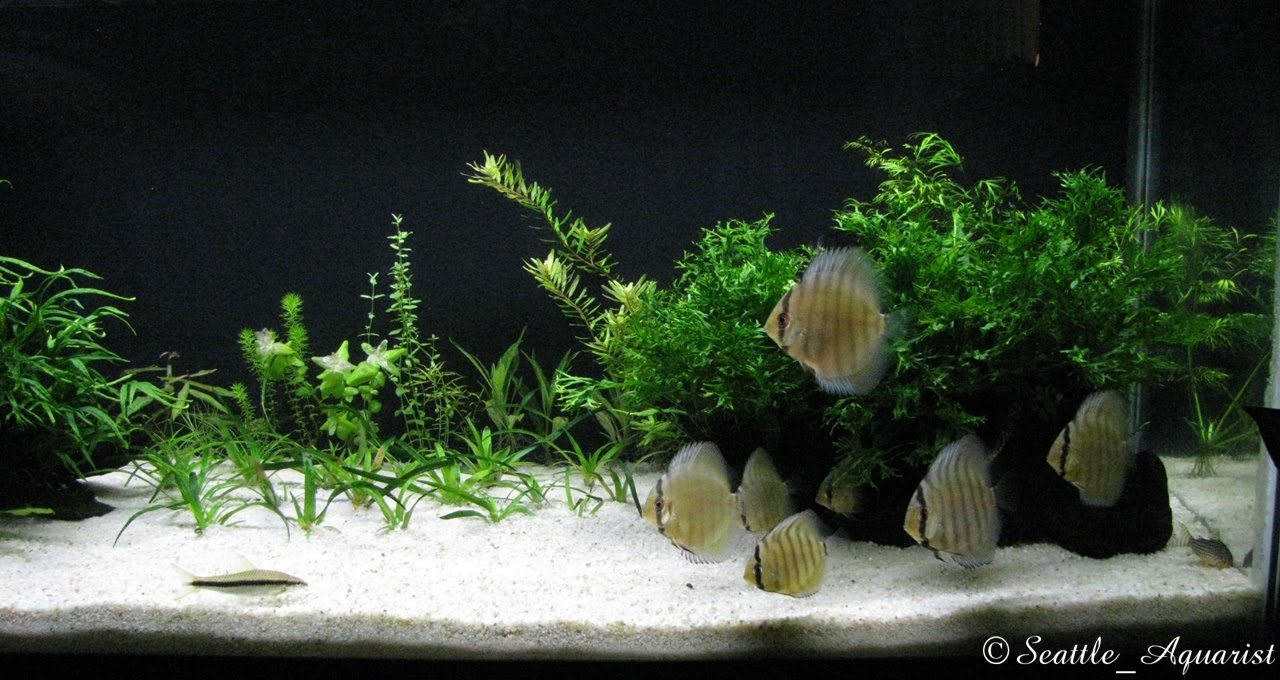
Eriocaulon 'Vietnam' showing necrosis of older leaves
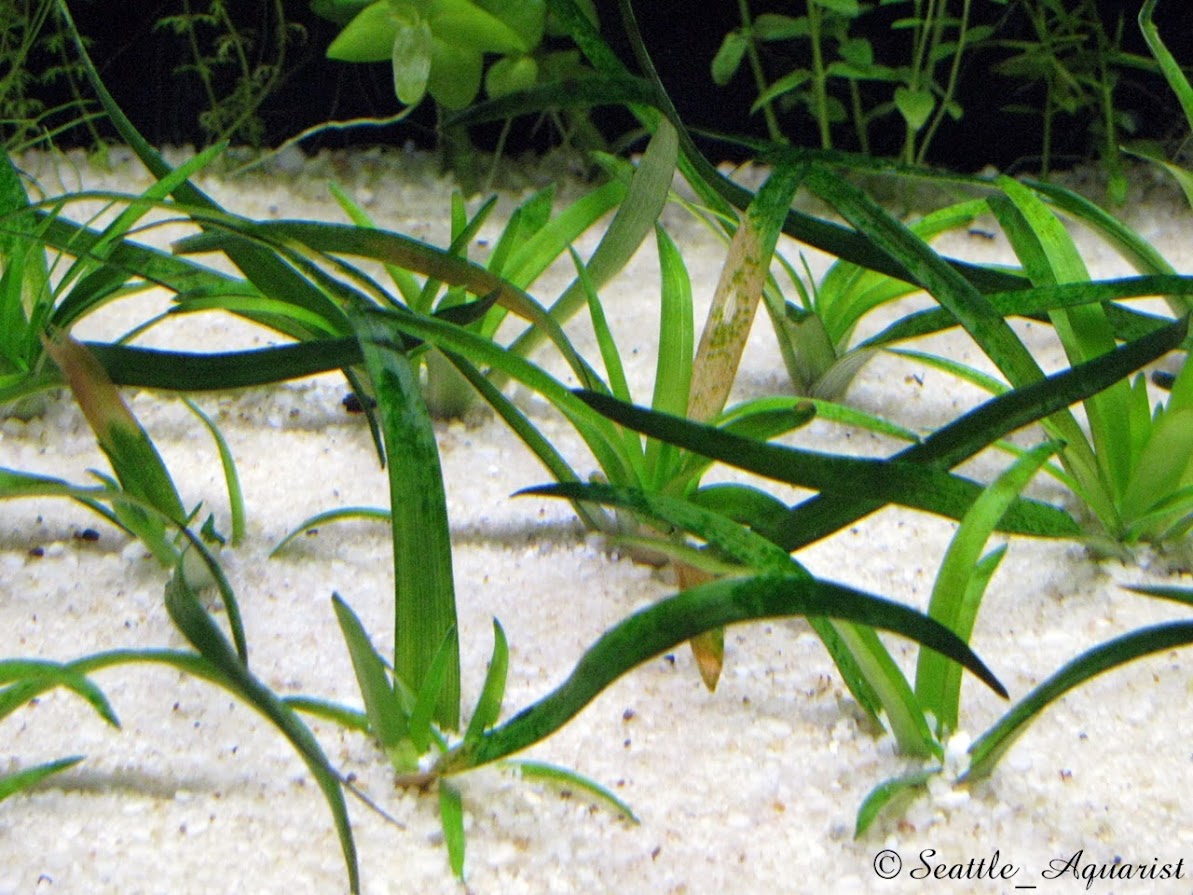
Bacopa colorata showing #1 deformed new leaves emerging and #2 curled under leaf margins

Limnophila rugosa showing interveinal chlorosis (dark leaf veins with lighter areas in between (sorry a little blurry)
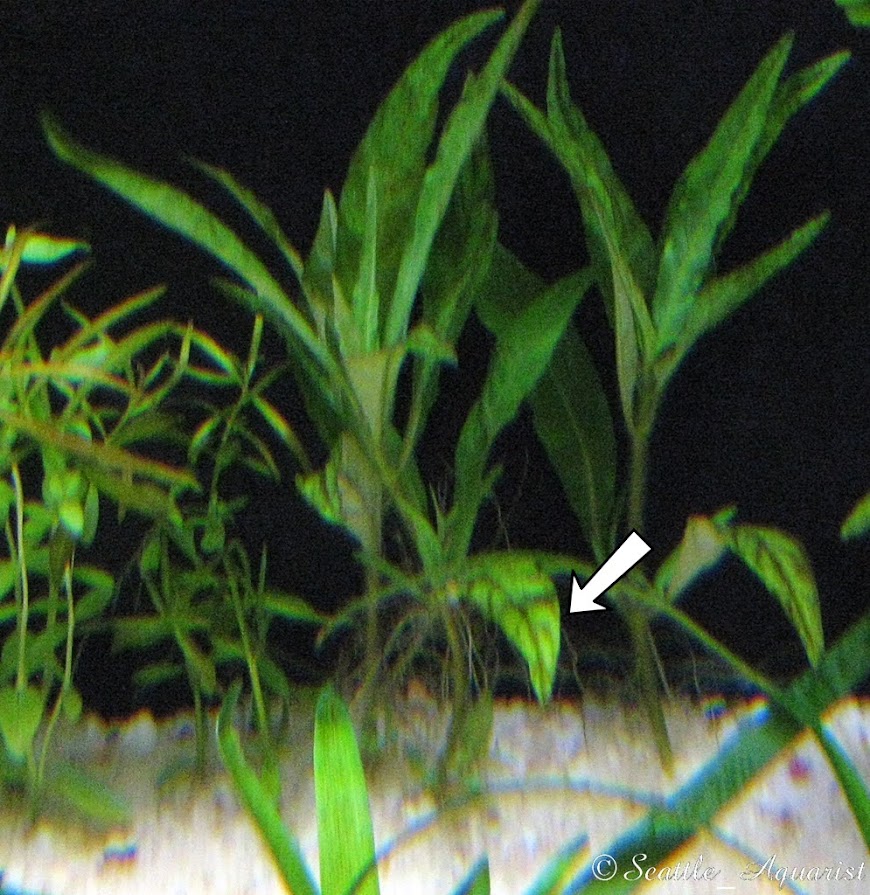
2020-08-21
Today I did a six (6) gallon water change. The tank has a water volume of 24 gallons so 25%. Here are the water parameters after the water change:
pH = 6.8
dKH = 2.0
dGH = 3.0
NH3 = 0.0 ppm
NO2 = 0.0 ppm
NO3 = 5.0 ppm
I did a light gravel vac in the front again, added 3/8 tsp of CaSO4 for 3 ppm of calcium, 3/8 tsp of MgSO4 for 2.0 ppm of Mg, and 3/16 tsp of K2SO4 for 7.5 ppm of potassium. Why did I dose those nutrients? I noticed the deformed new leaves of the Bacopa colorata which is likely insufficient calcium. I also noticed the necrosis occurring in the older leaves of the Eriocaulon 'Vietnam; likely insufficient potassium or magnesium. Lastly the Limnophila rugosa was showing interveinal chlorosis on the older leaves indicating insufficient magnesium and the older leaves of the Bacopa colorata have their leaf margins curling (under in this case) also indicating a need for more magnesium.
Eriocaulon 'Vietnam' showing necrosis of older leaves
Bacopa colorata showing #1 deformed new leaves emerging and #2 curled under leaf margins
Limnophila rugosa showing interveinal chlorosis (dark leaf veins with lighter areas in between (sorry a little blurry)
Seattle_Aquarist
Well-Known Member
Hi All,
2020-08-24
Monday and today is water change day for all my tanks! I have also been doing water changes on Thursday or Fridays as well however based on input on another forum I will likely increase the frequency. Today the tank got a little over 50% water change.
This last week the fish seem more acclimated. They are no longer staying in a tight school most of the time as they were the first week or so. Instead they are exploring and foraging more individually. All the discus are eating well (and continuously) and I've upped my food budget for the hobby.
I have received a lot of feedback on the forums where I have been posting this thread that "you can't raise discus in a planted tank" or "you can't keep discus in a planted tank, when you see pictures of discus in planted tanks they are only there for the photo and then returned to a bare tank". I honestly don't know if those individuals are sharing information based their own personal experiences or if just repeating something they have heard or read. In either case I propose to continue with this set-up unless the fish show signs of distress and/or I have trouble maintaining good water quality. Again, good fish growth and healthy fish are the primary concern....not the plants.
After the water change the water parameters in the tank were:
pH = 7.2
dKH = 2.0
dGH = 3.0
NH3 = 0.0 ppm
NO2 = 0.0 ppm
NO3 = 5.0 ppm
Other than the slight increase in pH which I attribute to the increased volume of the water change the parameters remain the same. After the water change I added 3/8 teaspoon of CaSO4 for 3 ppm of Ca; 3/16 teaspoon of MgSO4 for 1.0 ppm of Mg; and 3/16 teaspoon of K2SO4 for 7.5 ppm of K. I also did my weekly 15 ml of glutaraldehyde / Excel.
It's been almost exactly a month since I first added plants to the tanks and some are showing a strong ability to adapt to the low nutrient environment and some are not. Here are some pictures I took today.
Here is the obligatory full tank shot
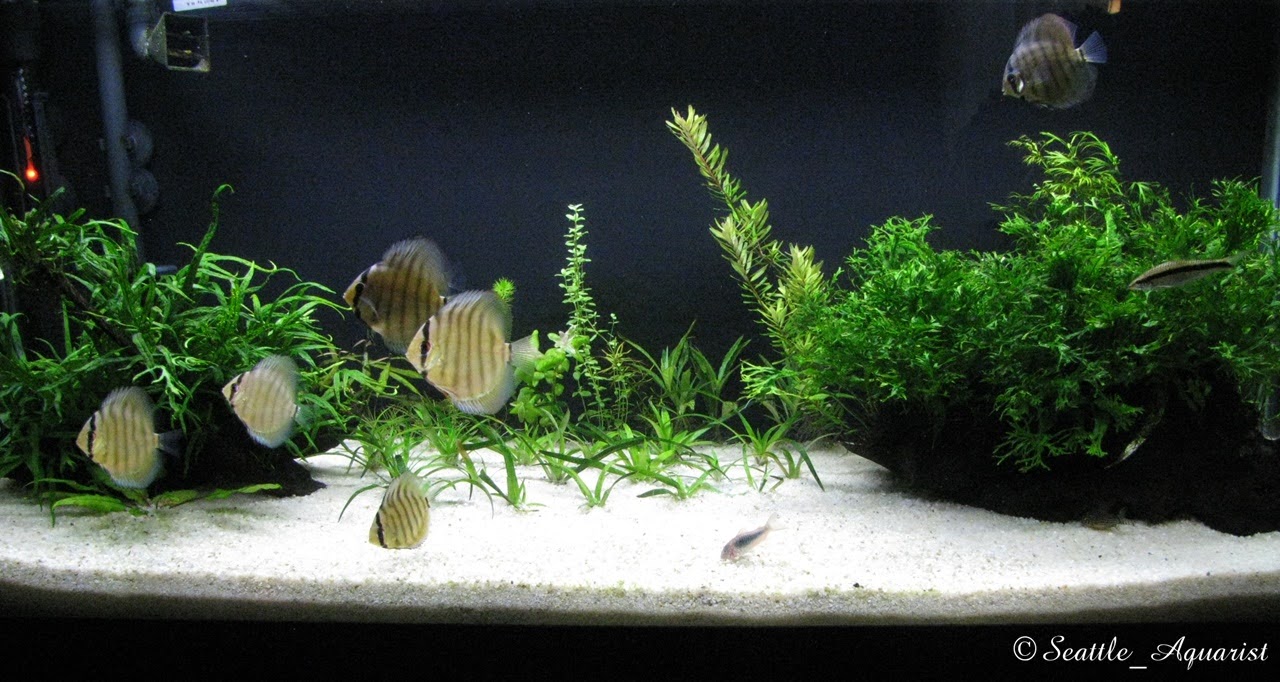
The 'Trident' java fern and Cryptocoryne 'Green Gecko' are doing fine
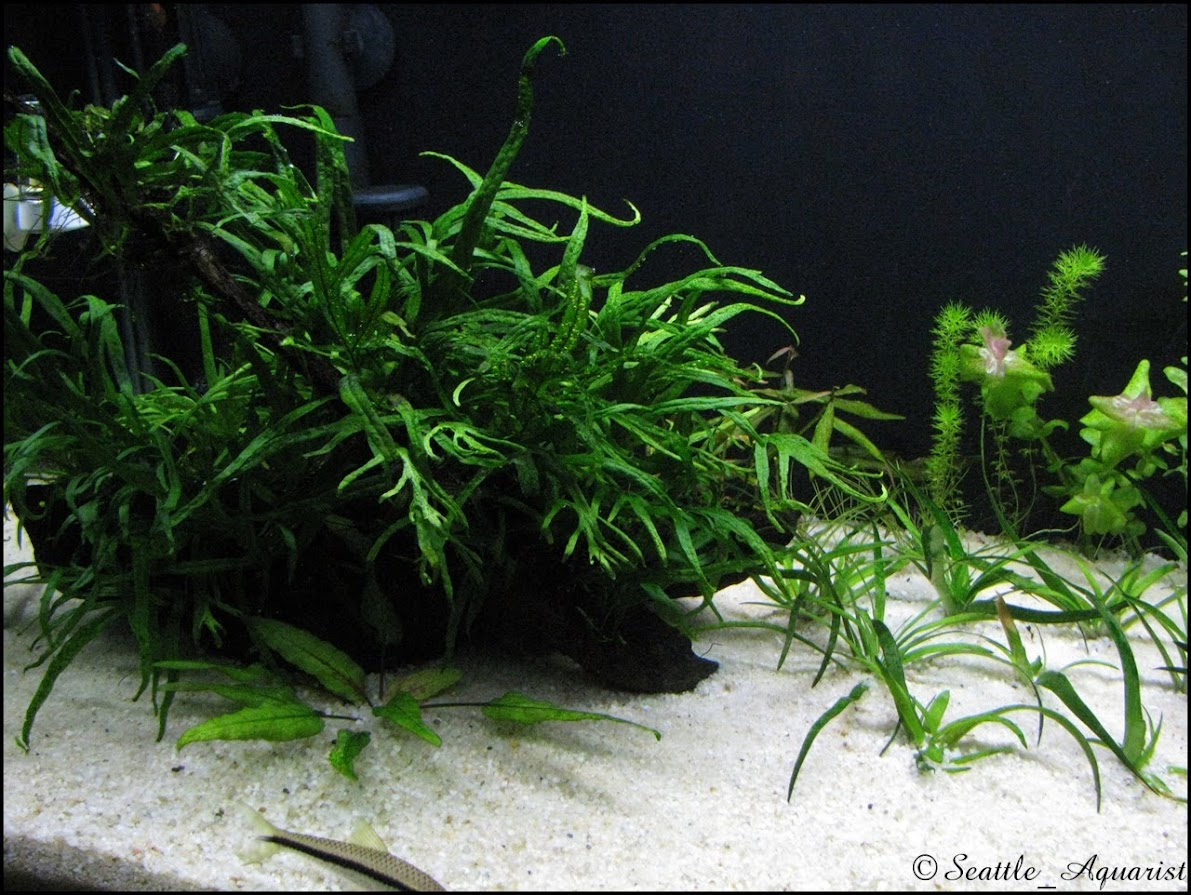
The Persicaria sp. 'Kawagoeanum' (left rear) is not liking the conditions; the Eriocaulon 'Vietnam' are just sitting there

The Myriophyllum sp. 'Guyana' is doing fine with a couple of inches of new growth; I'm unsure if the Bacopa colorata will adapt or not; and the small Eleocharis (hairgrass) plants are starting to put out runners
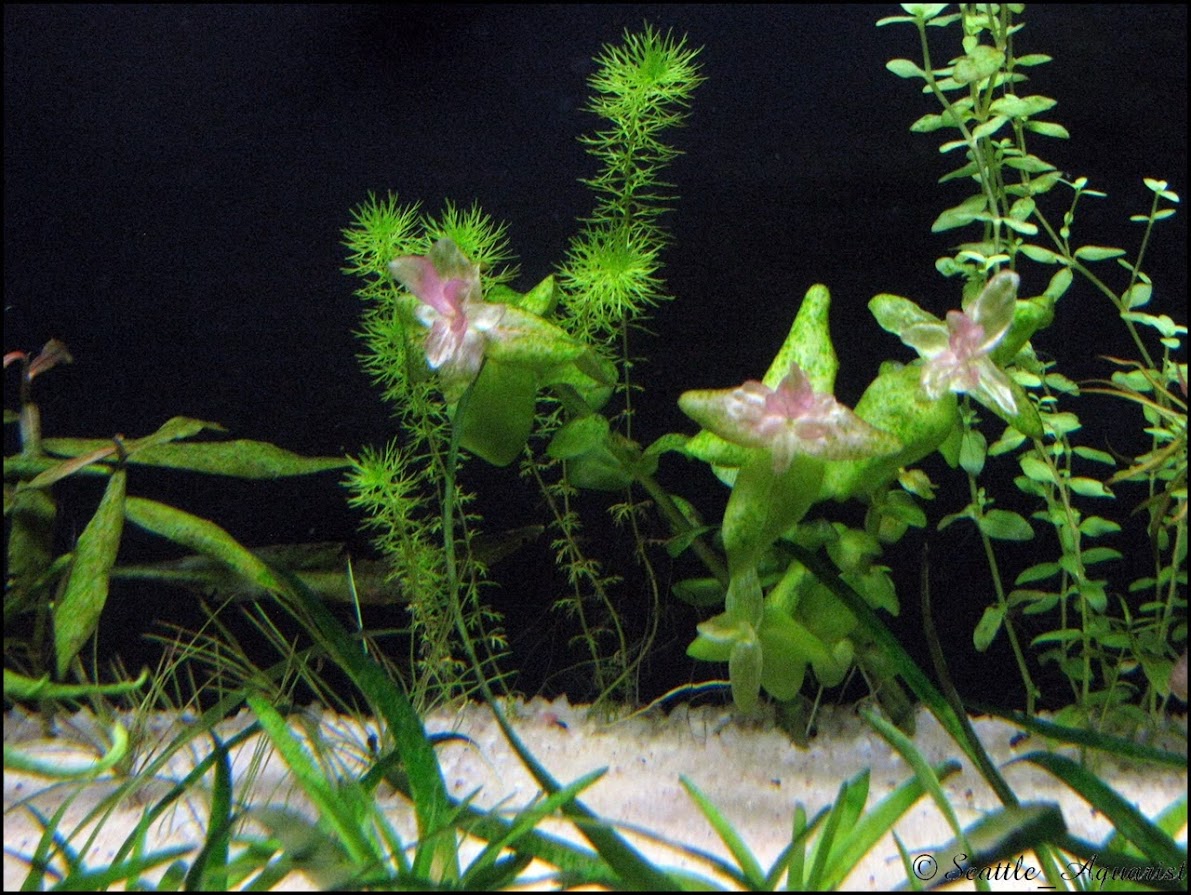
The Oldenlandia salzmannii is adapting well (left), as are the few sprigs of Ludwigia arcuata however the Limnophila rugosa is not doing much

The Ludwigia sp 'Red' is growing very well but not much color with PAR@75

2020-08-24
Monday and today is water change day for all my tanks! I have also been doing water changes on Thursday or Fridays as well however based on input on another forum I will likely increase the frequency. Today the tank got a little over 50% water change.
This last week the fish seem more acclimated. They are no longer staying in a tight school most of the time as they were the first week or so. Instead they are exploring and foraging more individually. All the discus are eating well (and continuously) and I've upped my food budget for the hobby.
I have received a lot of feedback on the forums where I have been posting this thread that "you can't raise discus in a planted tank" or "you can't keep discus in a planted tank, when you see pictures of discus in planted tanks they are only there for the photo and then returned to a bare tank". I honestly don't know if those individuals are sharing information based their own personal experiences or if just repeating something they have heard or read. In either case I propose to continue with this set-up unless the fish show signs of distress and/or I have trouble maintaining good water quality. Again, good fish growth and healthy fish are the primary concern....not the plants.
After the water change the water parameters in the tank were:
pH = 7.2
dKH = 2.0
dGH = 3.0
NH3 = 0.0 ppm
NO2 = 0.0 ppm
NO3 = 5.0 ppm
Other than the slight increase in pH which I attribute to the increased volume of the water change the parameters remain the same. After the water change I added 3/8 teaspoon of CaSO4 for 3 ppm of Ca; 3/16 teaspoon of MgSO4 for 1.0 ppm of Mg; and 3/16 teaspoon of K2SO4 for 7.5 ppm of K. I also did my weekly 15 ml of glutaraldehyde / Excel.
It's been almost exactly a month since I first added plants to the tanks and some are showing a strong ability to adapt to the low nutrient environment and some are not. Here are some pictures I took today.
Here is the obligatory full tank shot
The 'Trident' java fern and Cryptocoryne 'Green Gecko' are doing fine
The Persicaria sp. 'Kawagoeanum' (left rear) is not liking the conditions; the Eriocaulon 'Vietnam' are just sitting there
The Myriophyllum sp. 'Guyana' is doing fine with a couple of inches of new growth; I'm unsure if the Bacopa colorata will adapt or not; and the small Eleocharis (hairgrass) plants are starting to put out runners
The Oldenlandia salzmannii is adapting well (left), as are the few sprigs of Ludwigia arcuata however the Limnophila rugosa is not doing much
The Ludwigia sp 'Red' is growing very well but not much color with PAR@75
...I have received a lot of feedback on the forums where I have been posting this thread that "you can't raise discus in a planted tank" or "you can't keep discus in a planted tank, when you see pictures of discus in planted tanks they are only there for the photo and then returned to a bare tank". I honestly don't know if those individuals are sharing information based their own personal experiences or if just repeating something they have heard or read. In either case I propose to continue with this set-up unless the fish show signs of distress and/or I have trouble maintaining good water quality. Again, good fish growth and healthy fish are the primary concern....not the plants...
Looking good, Roy! I see no reason whatsoever that this should not work, despite the 'conventional wisdom' online, given the level of care and maintenance that you are lavishing on this tank. Sure discus are challenging, but could you be doing anything more to keep them happy, plants or no? I don't see how. So much online information is just a rehash of established mythology, much of it ill-founded.
I'm curious about the glutaraldehyde. Are you doing this as prophylaxis for parasites? I do that sometimes for my wild fishes, using SeaChem Paraguard, but not for tank-raised specimens.
Looking forward to the next update!
Seattle_Aquarist
Well-Known Member
Hi @sir_keith
Seachem Excel is sold as a carbon supplement for planted tanks. If the 'limiting factor' in plant growth is available carbon molecules Excel will increase plant growth. It also has algaecide properties. The active ingredient in Excel is glutaraldehyde. Many years ago I got tired of paying for Excel and purchased glutaraldehyde and now mix my own Excel strength glut. I don't dose it for the carbon molecules since all but one of my tanks has CO2 but I do one dose a week for the algaecide properties.
I've heard that Paraguard is a very good medication.
Seachem Excel is sold as a carbon supplement for planted tanks. If the 'limiting factor' in plant growth is available carbon molecules Excel will increase plant growth. It also has algaecide properties. The active ingredient in Excel is glutaraldehyde. Many years ago I got tired of paying for Excel and purchased glutaraldehyde and now mix my own Excel strength glut. I don't dose it for the carbon molecules since all but one of my tanks has CO2 but I do one dose a week for the algaecide properties.
I've heard that Paraguard is a very good medication.
Ah, good to know. I wonder if I should try that for my Anubias. I can't imagine they are lacking for minerals in my hard water, but they do shed leaves periodically, mostly from the base of the rhizome. The other end is growing fine, so I've just assumed this is normal. But I'm at the low end of the curve regarding plant cultivation, so what do I know? 

Seattle_Aquarist
Well-Known Member
Hi All,
2020-08-25
Added 4.5 ml of Seachem Flourish Comprehensive
2020-08-26
Based upon recommendations from folks on the forums I have upped my water changes. I will be doing three a week on this 30 gallon tank (24 gallon water volume) with 12 gallons done on Monday, 9 gallons done on Wednesday, and 9 gallons done on Friday. This will be the equivalent of 1.33 complete water changes per week. I did a 9 gallon water change today, did a light vac of the substrate in the front, noticed some green spot algae (GSA) along the front glass just below the substrate line and cleaned that up. Magic Erasers (aka melamine foam) are great glass cleaners (be sure to get the ones with no detergent etc).
After the water change I added 3/4 tsp of CaSO4*2H2O for 6 ppm of Ca (hardness increase approx 0.8 dGH); 3/8 tsp of MgSO4*7H2O for 2.1 ppm of Mg (harness increase 0.5 dGH); 3/8 tsp of K2SO4 for 11.8 ppm of K; and 3/64 tsp of KH2PO4 for 2.0 ppm of P to hopefully reduce the GSA. I also added 4.5 ml of Seachem Flourish Comprehensive.
2020-08-29
I did a 9 gallon water change (approx 33%+) today. Also picked up some live adult brine shrimp to give them a little treat. Here they are 1/2 hour after feeding still looking for any BS they may have missed.
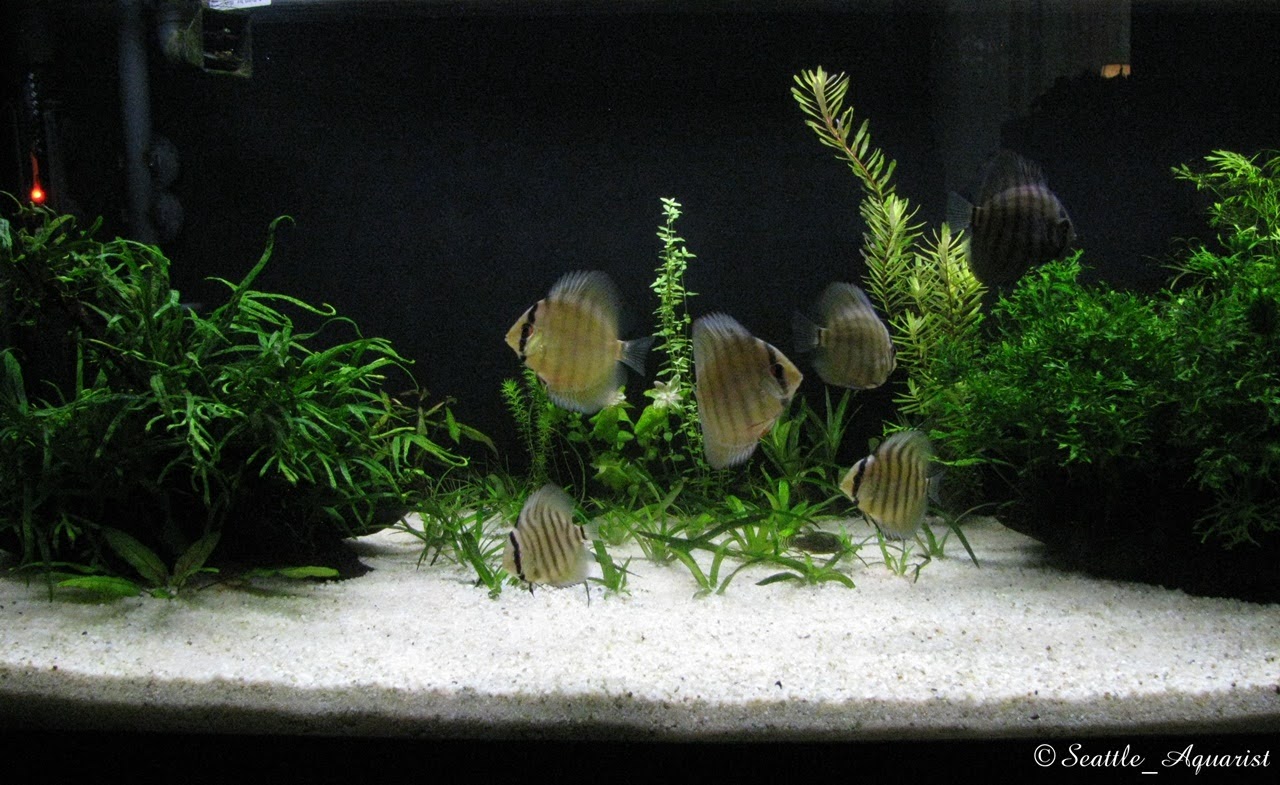
Also here is a picture of the big brothers and sisters of the fry I have, notice how the nice coloration is starting to emerge.
[I

2020-08-25
Added 4.5 ml of Seachem Flourish Comprehensive
2020-08-26
Based upon recommendations from folks on the forums I have upped my water changes. I will be doing three a week on this 30 gallon tank (24 gallon water volume) with 12 gallons done on Monday, 9 gallons done on Wednesday, and 9 gallons done on Friday. This will be the equivalent of 1.33 complete water changes per week. I did a 9 gallon water change today, did a light vac of the substrate in the front, noticed some green spot algae (GSA) along the front glass just below the substrate line and cleaned that up. Magic Erasers (aka melamine foam) are great glass cleaners (be sure to get the ones with no detergent etc).
After the water change I added 3/4 tsp of CaSO4*2H2O for 6 ppm of Ca (hardness increase approx 0.8 dGH); 3/8 tsp of MgSO4*7H2O for 2.1 ppm of Mg (harness increase 0.5 dGH); 3/8 tsp of K2SO4 for 11.8 ppm of K; and 3/64 tsp of KH2PO4 for 2.0 ppm of P to hopefully reduce the GSA. I also added 4.5 ml of Seachem Flourish Comprehensive.
2020-08-29
I did a 9 gallon water change (approx 33%+) today. Also picked up some live adult brine shrimp to give them a little treat. Here they are 1/2 hour after feeding still looking for any BS they may have missed.
Also here is a picture of the big brothers and sisters of the fry I have, notice how the nice coloration is starting to emerge.
[I